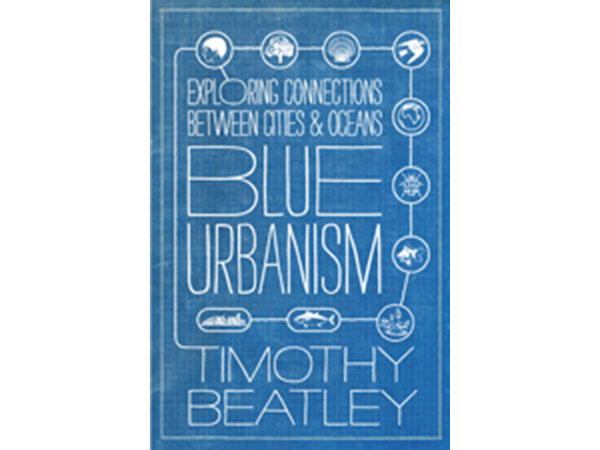
Author: Timothy Beatley (Island Press, 2014)
Humanity has an intrinsic sense of what our urban world entails. When we hear the word urbanism, we think of infrastructure. Concrete. Glass. Roads. Parks. Houses. What we never pause to think of is water, and not the water that runs from our tap, but the synergistic relationship we have with the oceans and rivers that make up the majority of this planet. We hear about the changing habits of water on a daily basis – shortages, dams, storm water runoff – but before Blue Urbanism, I had yet to read a good book that tackled issues around the urban environment and one of the most important aspects of our planet: the ocean.
The book has eight chapters which focus on different aspects of our urban connection to water. They cover everything from fish populations to parks to “blue belts,” a phrase I had never heard before. The book begins with a chapter on the ocean and urban environment. It includes some fantastic facts to consider: “350 million jobs globally are dependent on oceans, and the annual trade in fish and seafood generates $108 billion.” These facts alone are staggering and Beatley is just getting started at this point. To make things stronger, he contrasts our negligence – and strong amounts of apathy – towards our oceans with the strong upswing of care we are investing into our cities and infrastructure. Beatley even coins the term “ocean sprawl” to define some of the harmful acts that are taking place within our oceans as our on-land activities migrate farther and farther out to sea.
We know of several roads or highways that have transected wildlife habitats to the point that we post signs warning of possible collisions with animals crossing roads that are unfamiliar with them. Yet, we don’t erect signs in the middle of shipping routes to stop from crossing migratory paths of whales or dolphins who are killed en masse by the increasingly staggering amount of tankers crossing our oceans. Definitely food for thought.
Reading through Blue Urbanism, I often found myself wondering what type of approach – focusing on positive vs negative aspects – would be more effective in instigating a paradigm shift. This is truly a million-dollar question and I was not asking this from a cynical point of view, or to undermine any of the great statistical work that Beatley accomplishes. We hear frequently about the many wrongs we do, yet no change seems to occur. To his credit, Beatley is truly a champion in this area, showing a passion from chapter to chapter that brings the ocean to the table for discussion.
As I finished Blue Urbanism I was struck again by the thought that something so integral to our lives – water, oceans – can hide just out of our field of view because it doesn’t directly impact our day to day life (a fact pointed out by Beatley). This is all too common and the absurdness I felt at times reading over Beatley’s passionate words made me question (in a good sense) my own ability to see everything as a whole. Without seeing the ocean as part of the picture, we are not seeing the full image, and thusly are making decisions which may short-sightedly benefit our urban lifestyle, to the detriment of our oceans.
It is clear that a healthier, more cohesive connection needs to be made between the two. One that breeds a prosperous future……this, to me, was the main message I took away from the book. The ideas of “Blue Belts” should not cause a chuckle for their seemingly odd place in the urban language, but should be reflected upon seriously. I feel fortunate to have been able to come to this realization through reading Blue Urbanism…..a fantastic book for anyone wanting to see positive changes made to protect our fragile ecosystems.
***
To find out more about Blue Urbanism: Exploring Connections Between Cities and Oceans, visit the Island Press website. Also worth reading is Timothy Beatley’s essay Blue Urbanism: The City and The Ocean at the Design written for PLACES (Design Observer).
**
Jeremy Senko is happily lost in the world of theoretical architecture and design. He is forever a student at heart, consistently reading, experiencing and learning about the world he inhabits. More specifically, he recently completed his Bachelor of Interior Design at Kwantlen Polytechnic University, where he pushed the limits (and the patience) of his professors.

